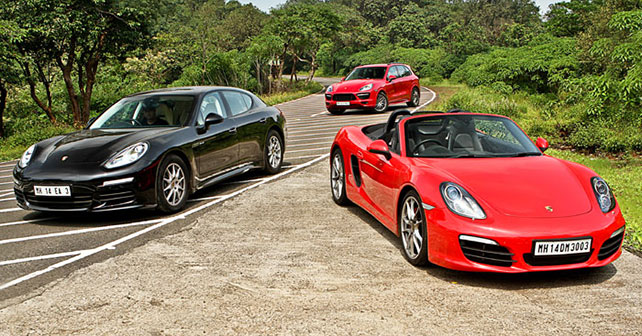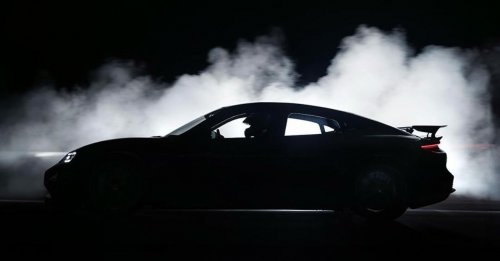... or at least for this feature, that is. Three cars separated by cosmic distances in nature, and, yet, they hold the same spirit.
How do you write about three massively different cars in a single article – especially when they share the same brand logo? It’s quite like comparing Captain America, Thor, and Ironman from a single franchise – The Avengers.
The Panamera is like Captain America – mature, polite, and very accommodating. Also, the one with literally no sense of fashion – smart attire is an alien idea to it. Thor is the epitome of muscle and brute force – he’s the thunder God, and has an inherent childlike attitude, but is also quite mature when it matters. The Cayenne, in the trio of cars here, exhibits much the same characteristics. The Boxster is Ironman – flamboyant, eternally charming, self assured, and immediately effective. But there’s also a hint of sensuality – a hint of Scarlett Johansson, a.k.a. Black Widow – about these cars. And to know that is immensely satisfying!
The reason we’ve gathered the three Porsches you see in these pages is for one reason, and one reason alone – to celebrate the spirit of Porsche. The spirit of driving. And since this is about driving and fun, I’ll stick to talking mostly about that. So, those of you looking for an outright comparison based on numbers and features, please work your fingers on the keyboard and look at any one of the various websites that will willingly provide that data.
The Panamera here is the only car that’s got an appetite for diesel. Its 3-litre, six-cylinder engine is a common-rail direct-injection affair that produces 247bhp and 550Nm. In a space of sporty saloons, these are all but modest numbers. And because the Panamera bears a Porsche badge on its sheet metal, it automatically gets classified as a sports sedan. But that’s missing the point. The Panamera is – and it’s really odd for me to say this for a Porsche – essentially centred around a relaxed cruising experience. Of course, with a sticker price of over a crore, you’d expect the Panamera to come stacked with all the equipment and features that have practically become standard now. It does. And then some. So, there really isn’t any point talking about those things. Let’s just say that it’s got a lot of acronyms in its equipment list. As I said before, I’m not going to delve too much into such things.
Once we exited the confines of the city and started heading towards more entertaining roads – quite rapidly at that – the Panamera started growing on me. I’d never really liked the Panamera. Good thing that I was driving it first from the trio we had; it solved two things – one, I didn’t have to look at its questionable shape, and, two, when I’d eventually have to, I wouldn’t mind much because it’s bloody good at what it does (as I found out during my drive).
Along the smooth, straight roads, the Panamera is an absolute charmer – the ride is glorious, and the seats are fabulous. It’s a brilliant cruiser, and does the job of eating up miles with effortless ease. It disconnects you from any feeling of discomfort that the road might be trying to send through your senses. It’s so plush, the ride, that the Panamera can start feeling very artificial to drive, even boring – if I dare use that word. But, along such roads, how much fun can you indulge in anyway? It’s when the twisty stuff starts that the Panamera changes its character dramatically. No, it doesn’t transform into some fire-breathing dragon from a parallel land, but get it into the sports setting and turn the traction control off and it does shift enthusiastically. For a 4-door super luxury sedan that weighs in at almost 2 tonnes, the Panamera is a fantastic driving experience.
The engine and transmission are bolted to form one drive unit, and the power is transmitted to the rear wheels via an 8-speed Tiptronic gearbox. It’s not a very engaging combination – you’re left wanting more from it. The chassis is very capable, however, and the handling is crisp. You turn in expecting the front to wash out on you, but the Panamera sticks to its line. That surprises you, and you press deeper into the wonderfully soft carpet, but it never really becomes an event that’ll force you to pray to God to save your life. Yes, it rolls and pitches, but you expect it to do that – it’s a heavy 4-door, 4-seater family sedan, after all! Which the Cayenne is, too, but of a dramatically different kind to the Panamera.
At the time it was conceptualized, and then produced, purists ridiculed the Cayenne. Many said that, even as an idea, it was wrong – a specialist sports car maker venturing into the mass segment, relatively speaking of course. But look at what this SUV has done for the brand – it’s central to the company’s functioning, and is responsible for the huge profits Porsche has been banking in over the years. Never mind the body type, the Cayenne has the Porsche tag attached to it, so it ought to be special. And sporty. It is both.
It’s plain silly, the kind of performance the Cayenne GTS brings along to the party. You don’t expect a gargantuan SUV like it to go this fast, to sound this good, and to corner as nicely as the GTS does. Even the numbers are hilarious when you stack them all up together – 4.8 litre V8, 415bhp, over 2 tonnes, and over one crore. Those are numbers at the business end of things, no matter which way you look at them. The GTS is an SUV of mammoth proportions, and though it may brag about its drag coefficient being just 0.37, it still somehow feels like you’re driving a house when you’re going heavy on the throttle and quick on the steering wheel. Don’t – not for a moment – think that it’s not exciting; it is very exciting, and perhaps the most enthusiastic and mental SUV I’ve ever driven, but there are moments of terror that you encounter too.
The GTS has massive footprint – 275-section low-pro tyres on 20-inch wheels – which lends it reasonably good amounts of grip and you sense a lot of traction, but the sheer weight of the Cayenne gives it away. Even under braking, you can feel the tendency of the entire rear end of the vehicle trying to consume the front. The brakes are effective though – and the discs are as big as the Moon. But then you need such ferocity in braking when you have 415 horses going full pelt.
What was an absolute joy, however, was the steering – it’s precise, but in a bizarre kind of way. You can place it with super confidence, and the GTS will turn-in very nicely, but there’s so much of weight to hustle around that you’re never quite sure whether you should keep it pinned or back off before you get a mini heart attack! Let’s just say that if I were doing a video while driving the GTS in a, well, sporty way, I wouldn’t be speaking an awful lot. I’d be very quiet actually – concentrating hard.
Yes, the Cayenne GTS can be hard work. Put it in the sportiest of the settings and it’s a tricky thing to drive fast, but once you get around its inadequacies and learn how to manage its weight effectively, you can throw it around and it’ll plaster a smile on your face – so-much-so that you’ll roll down your window to flaunt a beaming bright smile to your mates.
The Boxster is totally different in character. We had the ‘S’ version, which means there was 50 more horsepower at our disposal against the standard 261bhp Boxster. I’ll let you in to a little secret here – my absolute favourite regular-production Porsche has always been the Cayman ever since it came out, not the 911 that almost 99% of other people would choose. The Boxster was so much fun that it’s now worryingly close to the Cayman to become my new favourite. Plus, the fact that it’s a convertible does the job of enhancing its appeal that much more.
The Boxster S was easily the best product here. It felt the purest of the three, and the experience it provided from behind the wheel was biblical – relatively speaking, again. Yes, there are more powerful sports cars – some even look better than the Boxster – but in terms of sheer driving pleasure, few can ever match it. From the moment you sit in it, you feel absolutely at one with the car. You don’t so much sit inside it, as wear it around you.
The Boxster, in its latest form, has undergone an extensive makeover from the previous model. It used to share its doors with the 911. But they’ve been dumped in favour of completely new ones, which has allowed for a lot of tech-related magic to happen. For starters, the front and rear overhangs are now considerably shorter – pushing the wheels to the absolute corners of the car, which aids handling. The wheelbase is longer by 60mm, and the axle width at the front is wider by 40mm. The overall architecture has changed, and the new Boxster is quite a bit lighter than the old model.
The Boxster is, in the truest sense of it, a proper sports car – so, agility and keenness come naturally to it. The chassis is playful, yet totally controllable. The ride is firm, but not irritatingly so. The steering – oh yes, the steering. I don’t quite know why people are making so much fuss about the electronic power assisted steering mechanism (EPAS)? I think it’s pretty damn amazing – gives you ample feedback, it’s extremely quick, and doesn’t let you sense that artificial intelligence is intruding at all. It’s just great, frankly! And then, there’s the noise. The Boxster S makes 311bhp, and the sound it makes from the tail pipes is quite absorbing and addictive – the pops and the crackles on the overrun make you become a child and indulge in it over-and-over again.
But the best bit – the absolutely best – is that it’s blinding fast around twisty hill roads. The Boxster corners flat, and the urgency of the manner in which it changes direction will make you giggle. The PDK may not be as physically involving as a manual, but it’s so well mated to the engine that it really feels as if it’s as eager to have fun as you are. Step on the gas with the traction control switched off, and the rear lets go – but it’s never too much. Slight countersteer action and modulate the throttle to get it back – it’s all so rewarding! Damn – Cayman or Boxster? Big dilemma!
It was a glorious day – a beautiful setting, brilliant roads, and three cars that couldn’t be more different, yet be so similar. I’m heartbroken that we had to leave those cars back and come back to work.
- Porsche Panamera Diesel
- Porsche Cayenne GTS
- Porsche Boxster S
Engine: 3-litre, V6, Turbocharged, Common-Rail Direct Injection
Fuel: Diesel
Transmission: 8-speed automatic (Tiptronic) Rear-wheel drive
Power: 247bhp @ 3,800-4,400rpm
Torque: 550Nm @ 1,750-2,750rpm
Price: Rs.1.24 crores (ex-showroom, delhi)
Engine: 4.8-litre, V8, Direct Injection
Fuel: Petrol
Transmission: 8-speed automatic (Tiptronic S) All-wheel drive
Power: 415bhp @ 6,500rpm
Torque: 515Nm @ 3,500Nm
Price: Rs. 1.17 crores (ex-showroom, delhi)
Engine: 3.4-litre, flat-six, Direct Injection
Fuel: Petrol
Transmission: 7-speed dual-clutch (PDK) Rear-wheel drive
Power: 311bhp @ 6,700rpm
Torque: 360Nm @ 4,500-5,800rpm
Price: Rs. 92 lakhs (ex-showroom, delhi)




















































Write your Comment